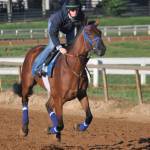Aerobic and Anaerobic Exercise in Horses

Most of a horse’s large muscles that are used during exercise contain a mixture of muscle fiber types. These may be type 1, 2A, or 2B.
Type 1 (slow-twitch) fibers contract slowly and are able to function for a relatively long time without fatigue, and are thus ideally suited for endurance riding. Type 1 fibers have a high density of mitochondria, conferring a high aerobic or oxidative capacity. They also have the highest oxidative capacity, lipid (fat) stores, and capillary density as well as the lowest glycogen stores and glycolytic enzyme capacity. Fast-twitch (type 2) muscle fibers are divided into type 2A and 2B fibers.
Type 2B fibers have the fastest contractile speed, the largest cross-sectional area, the highest glycogen stores and glycolytic capacity, and the lowest oxidative capacity. They are ideally suited to short, intense bursts of power. Type 2A fibers are intermediate in contractile speed and metabolic properties between type 1 and type 2B fibers.
At submaximal exercise speeds, oxygen is readily available and slow-twitch fibers as well as fast-twitch fibers with a high oxidative capacity are recruited for aerobic exercise. Intramuscular supplies of energy are quickly utilized and more energy must be derived by processes within the horse’s body. The amount of glucose and free fatty acids (FFA) carried by the blood and available for oxidation increases within 15 minutes of submaximal exercise in conjunction with an increasing concentration of cortisol and decreased concentrations of insulin. High rates of oxidative phosphorylation result in a slowing of glucose oxidation in favor of the use of FFA. As such, the rate of intramuscular glycogen use steadily declines over time as the oxidation of FFA increases.
Oxidative metabolism is highly efficient. It provides much more usable energy per molecule of substrate (glucose or FFA) than glycolysis without altering intracellular pH. By using FFA, intramuscular glycogen stores are spared. Fatigue during prolonged submaximal exercise happens when a combination of the following occurs: intramuscular glycogen concentrations become depleted, muscle temperatures become markedly elevated, electrolyte concentrations are altered, or neuromuscular fatigue occurs. Very little lactic acid accumulates at fatigue in horses performing submaximal exercise.
With any form of exercise a small amount of anaerobic metabolism occurs, but at submaximal speeds the majority of energy is produced by aerobic metabolism. As the speed of exercise increases, so does the energy demand placed on the muscle. More muscle fibers are recruited, including type 2B fibers, and more oxygen is consumed by the horse until it reaches a speed where the delivery of oxygen or the ability to utilize oxidative processes becomes limiting. At the point of maximum oxygen consumption (VO2max), any further energy must be generated by anaerobic glycolysis. With their rich supply of glycolytic enzymes and limited capacity for oxidative phosphorylation, type 2B fibers are uniquely suited for anaerobic glycolysis. With type 2B fiber recruitment at speeds at and beyond the point of maximal oxygen uptake, a sharp rise in blood lactate accumulation occurs.
The advantage of anaerobic glycolysis is that it provides a rapid supply of ATP without the need for oxygen. Maximal exercise is limited not by depletion of glycogen stores but instead by a buildup of lactic acid before total muscle glycogen is depleted. This lactate increase causes low intramuscular pH, which limits the use of glycogen. Muscle pH can fall as low as 6.4 following maximal exercise, at which point both glycolysis and proper muscle cell contraction are inhibited. Diffusion of lactate into the general circulation, where bicarbonate acts as a major blood buffer, is also important for intramuscular pH. The amount of lactic acid in the circulation following exercise is in part directly related to the percentage of low oxidative type 2B fibers in the muscle and the duration of high-intensity exercise.
If extreme exercise continues, the muscle eventually is unable to keep up with energy demands and lactic acid disbursement. Ultimately, fatigue appears to be related to depleted energy stores within muscle fibers. The levels of lactate and energy in individual fibers during maximal exercise may be more important for the onset of fatigue than the measured concentrations in whole muscle samples. Depleted fibers might develop a sustained painful contracture, and this cramping impairs the horse’s ability to maintain maximal speed.
To allow the horse to exercise in comfort, owners need to be sure it is properly nourished and trained for the performance that is expected. Ingested carbohydrate, fat, and fiber can all be used as energy sources; electrolytes should be replaced by supplementation if the exercise period is long and the horse is sweating or performing in a hot, humid climate; and adequate water should be made available.
A training period that begins with short periods of easy exercise and progresses gradually to longer periods of more intense exercise can help to prepare a horse for whatever activity the rider has selected. Riders should always observe their horses for signs of fatigue (elevated pulse or body temperature that does not drop rapidly at breaks, excessive sweating, weakness, muscle cramping, inability to perform) and decrease or stop exercise before the horse becomes overly tired.








